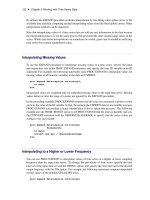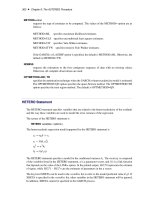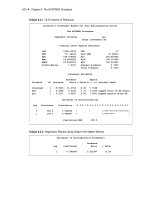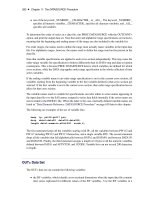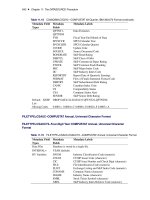SAS/ETS 9.22 User''''s Guide 4 potx
Bạn đang xem bản rút gọn của tài liệu. Xem và tải ngay bản đầy đủ của tài liệu tại đây (202.92 KB, 10 trang )
22 ✦ Chapter 2: Introduction
your own SAS programs in lowercase, uppercase, or a mixture of the
two.
UPPERCASE BOLD
is used in the “Syntax” sections’ initial lists of SAS statements and
options.
oblique
is used for user-supplied values for options in the syntax definitions. In
the text, these values are written in italic.
helvetica
is used for the names of variables and data sets when they appear in the
text.
bold is used to refer to matrices and vectors and to refer to commands.
italic
is used for terms that are defined in the text, for emphasis, and for
references to publications.
bold monospace
is used for example code. In most cases, this book uses lowercase type
for SAS statements.
Where to Turn for More Information
This section describes other sources of information about SAS/ETS software.
Accessing the SAS/ETS Sample Library
The SAS/ETS Sample Library includes many examples that illustrate the use of SAS/ETS software,
including the examples used in this documentation. To access these sample programs, select
Help
from the menu and then select
SAS Help and Documentation
. From the
Contents
list, select the
section Sample SAS Programs under Learning to Use SAS.
Online Help System
You can access online help information about SAS/ETS software in two ways, depending on whether
you are using the SAS windowing environment in the command line mode or the pull-down menu
mode.
If you are using a command line, you can access the SAS/ETS help menus by typing
help
on the
SAS windowing environment command line. Or you can issue the command
help ARIMA
(or
another procedure name) to display the help for that particular procedure.
If you are using the SAS windowing environment pull-down menus, you can pull-down the
Help
menu and make the following selections:
SAS Short Courses ✦ 23
SAS Help and Documentation
Learning to Use SAS in the Contents list
SAS Products
SAS/ETS
The content of the Online Help System follows closely that of this book.
SAS Short Courses
The SAS Education Division offers a number of training courses that might be of interest to SAS/ETS
users. Please check the SAS web site for the current list of available training courses.
SAS Technical Support Services
As with all SAS products, the SAS Technical Support staff is available to respond to problems and
answer technical questions regarding the use of SAS/ETS software.
Major Features of SAS/ETS Software
The following sections briefly summarize major features of SAS/ETS software. See the chapters on
individual procedures for more detailed information.
Discrete Choice and Qualitative and Limited Dependent Variable
Analysis
The MDC procedure provides maximum likelihood (ML) or simulated maximum likelihood estimates
of multinomial discrete choice models in which the choice set consists of unordered multiple
alternatives.
The MDC procedure supports the following models and features:
conditional logit
nested logit
24 ✦ Chapter 2: Introduction
heteroscedastic extreme value
multinomial probit
mixed logit
pseudo-random or quasi-random numbers for simulated maximum likelihood estimation
bounds imposed on the parameter estimates
linear restrictions imposed on the parameter estimates
SAS data set containing predicted probabilities and linear predictor (x
0
ˇ) values
decision tree and nested logit
model fit and goodness-of-fit measures including
– likelihood ratio
– Aldrich-Nelson
– Cragg-Uhler 1
– Cragg-Uhler 2
– Estrella
– Adjusted Estrella
– McFadden’s LRI
– Veall-Zimmermann
– Akaike Information Criterion (AIC)
– Schwarz Criterion or Bayesian Information Criterion (BIC)
The QLIM procedure analyzes univariate and multivariate limited dependent variable models where
dependent variables take discrete values or dependent variables are observed only in a limited range
of values. This procedure includes logit, probit, Tobit, and general simultaneous equations models.
The QLIM procedure supports the following models:
linear regression model with heteroscedasticity
probit with heteroscedasticity
logit with heteroscedasticity
Tobit (censored and truncated) with heteroscedasticity
Box-Cox regression with heteroscedasticity
bivariate probit
bivariate Tobit
sample selection models
Regression with Autocorrelated and Heteroscedastic Errors ✦ 25
multivariate limited dependent models
The COUNTREG procedure provides regression models in which the dependent variable takes
nonnegative integer count values. The COUNTREG procedure supports the following models:
Poisson regression
negative binomial regression with quadratic and linear variance functions
zero inflated Poisson (ZIP) model
zero inflated negative binomial (ZINB) model
fixed and random effect Poisson panel data models
fixed and random effect NB (negative binomial) panel data models
The PANEL procedure deals with panel data sets that consist of time series observations on each of
several cross-sectional units.
The models and methods the PANEL procedure uses to analyze are as follows:
one-way and two-way models
fixed and random effects
autoregressive models
– the Parks method
– dynamic panel estimator
– the Da Silva method for moving-average disturbances
Regression with Autocorrelated and Heteroscedastic Errors
The AUTOREG procedure provides regression analysis and forecasting of linear models with
autocorrelated or heteroscedastic errors. The AUTOREG procedure includes the following features:
estimation and prediction of linear regression models with autoregressive errors
any order autoregressive or subset autoregressive process
optional stepwise selection of autoregressive parameters
choice of the following estimation methods:
– exact maximum likelihood
– exact nonlinear least squares
26 ✦ Chapter 2: Introduction
– Yule-Walker
– iterated Yule-Walker
tests for any linear hypothesis that involves the structural coefficients
restrictions for any linear combination of the structural coefficients
forecasts with confidence limits
estimation and forecasting of ARCH (autoregressive conditional heteroscedasticity), GARCH
(generalized autoregressive conditional heteroscedasticity), I-GARCH (integrated GARCH),
E-GARCH (exponential GARCH), and GARCH-M (GARCH in mean) models
combination of ARCH and GARCH models with autoregressive models, with or without
regressors
estimation and testing of general heteroscedasticity models
variety of model diagnostic information including the following:
– autocorrelation plots
– partial autocorrelation plots
– Durbin-Watson test statistic and generalized Durbin-Watson tests to any order
– Durbin h and Durbin t statistics
– Akaike information criterion
– Schwarz information criterion
– tests for ARCH errors
– Ramsey’s RESET test
– Chow and PChow tests
– Phillips-Perron stationarity test
– CUSUM and CUMSUMSQ statistics
exact significance levels (p-values) for the Durbin-Watson statistic
embedded missing values
Simultaneous Systems Linear Regression
The SYSLIN and ENTROPY procedures provide regression analysis of a simultaneous system of
linear equations.
The SYSLIN procedure includes the following features:
estimation of parameters in simultaneous systems of linear equations
full range of estimation methods including the following:
Simultaneous Systems Linear Regression ✦ 27
– ordinary least squares (OLS)
– two-stage least squares (2SLS)
– three-stage least squares (3SLS)
– iterated 3SLS (IT3SLS)
– seemingly unrelated regression (SUR)
– iterated SUR (ITSUR)
– limited-information maximum likelihood (LIML)
– full-information maximum likelihood (FIML)
– minimum expected loss (MELO)
– general K-class estimators
weighted regression
any number of restrictions for any linear combination of coefficients, within a single model or
across equations
tests for any linear hypothesis, for the parameters of a single model or across equations
wide range of model diagnostics and statistics including the following:
– usual ANOVA tables and R-square statistics
– Durbin-Watson statistics
– standardized coefficients
– test for overidentifying restrictions
– residual plots
– standard errors and t tests
– covariance and correlation matrices of parameter estimates and equation errors
predicted values, residuals, parameter estimates, and variance-covariance matrices saved in
output SAS data sets
other features of the SYSLIN procedure that enable you to do the following:
– impose linear restrictions on the parameter estimates
– test linear hypotheses about the parameters
– write predicted and residual values to an output SAS data set
– write parameter estimates to an output SAS data set
– write the crossproducts matrix (SSCP) to an output SAS data set
– use raw data, correlations, covariances, or cross products as input
The ENTROPY procedure supports the following models and features:
generalized maximum entropy (GME) estimation
28 ✦ Chapter 2: Introduction
generalized cross entropy (GCE) estimation
normed moment generalized maximum entropy
maximum entropy-based seemingly unrelated regression (MESUR) estimation
pure inverse estimation
estimation of parameters in simultaneous systems of linear equations
Markov models
unordered multinomial choice problems
weighted regression
any number of restrictions for any linear combination of coefficients, within a single model or
across equations
tests for any linear hypothesis, for the parameters of a single model or across equations
Linear Systems Simulation
The SIMLIN procedure performs simulation and multiplier analysis for simultaneous systems of
linear regression models. The SIMLIN procedure includes the following features:
reduced form coefficients
interim multipliers
total multipliers
dynamic multipliers
multipliers for higher order lags
dynamic forecasts and simulations
goodness-of-fit statistics
acceptance of the equation system coefficients estimated by the SYSLIN procedure as input
Polynomial Distributed Lag Regression
The PDLREG procedure provides regression analysis for linear models with polynomial distributed
(Almon) lags. The PDLREG procedure includes the following features:
Nonlinear Systems Regression and Simulation ✦ 29
entry of any number of regressors as a polynomial lag distribution and the use of any number
of covariates
use of any order lag length and degree polynomial for lag distribution
optional upper and lower endpoint restrictions
specification of any number of linear restrictions on covariates
option to repeat analysis over a range of degrees for the lag distribution polynomials
support for autoregressive errors to any lag
forecasts with confidence limits
Nonlinear Systems Regression and Simulation
The MODEL procedure provides parameter estimation, simulation, and forecasting of dynamic
nonlinear simultaneous equation models. The MODEL procedure includes the following features:
nonlinear regression analysis for systems of simultaneous equations, including weighted
nonlinear regression
full range of parameter estimation methods including the following:
– nonlinear ordinary least squares (OLS)
– nonlinear seemingly unrelated regression (SUR)
– nonlinear two-stage least squares (2SLS)
– nonlinear three-stage least squares (3SLS)
– iterated SUR
– iterated 3SLS
– generalized method of moments (GMM)
– nonlinear full-information maximum likelihood (FIML)
– simulated method of moments (SMM)
supports dynamic multi-equation nonlinear models of any size or complexity
uses the full power of the SAS programming language for model definition, including left-
hand-side expressions
hypothesis tests of nonlinear functions of the parameter estimates
linear and nonlinear restrictions of the parameter estimates
bounds imposed on the parameter estimates
computation of estimates and standard errors of nonlinear functions of the parameter estimates
30 ✦ Chapter 2: Introduction
estimation and simulation of ordinary differential equations (ODE’s)
vector autoregressive error processes and polynomial lag distributions easily specified for the
nonlinear equations
variance modeling (ARCH, GARCH, and others)
computation of goal-seeking solutions of nonlinear systems to find input values needed to
produce target outputs
dynamic, static, or n-period-ahead-forecast simulation modes
simultaneous solution or single equation solution modes
Monte Carlo simulation using parameter estimate covariance and across-equation residuals
covariance matrices or user-specified random functions
a variety of diagnostic statistics including the following
– model R-square statistics
– general Durbin-Watson statistics and exact p-values
– asymptotic standard errors and t tests
– first-stage R-square statistics
– covariance estimates
– collinearity diagnostics
– simulation goodness-of-fit statistics
– Theil inequality coefficient decompositions
– Theil relative change forecast error measures
– heteroscedasticity tests
– Godfrey test for serial correlation
– Hausman specification test
– Chow tests
block structure and dependency structure analysis for the nonlinear system
listing and cross-reference of fitted model
automatic calculation of needed derivatives by using exact analytic formula
efficient sparse matrix methods used for model solution; choice of other solution methods
Model definition, parameter estimation, simulation, and forecasting can be performed interactively
in a single SAS session or models can also be stored in files and reused and combined in later runs.
ARIMA (Box-Jenkins) and ARIMAX (Box-Tiao) Modeling and Forecasting ✦ 31
ARIMA (Box-Jenkins) and ARIMAX (Box-Tiao) Modeling and
Forecasting
The ARIMA procedure provides the identification, parameter estimation, and forecasting of au-
toregressive integrated moving-average (Box-Jenkins) models, seasonal ARIMA models, transfer
function models, and intervention models. The ARIMA procedure includes the following features:
complete ARIMA (Box-Jenkins) modeling with no limits on the order of autoregressive or
moving-average processes
model identification diagnostics including the following:
– autocorrelation function
– partial autocorrelation function
– inverse autocorrelation function
– cross-correlation function
– extended sample autocorrelation function
– minimum information criterion for model identification
– squared canonical correlations
stationarity tests
outlier detection
intervention analysis
regression with ARMA errors
transfer function modeling with fully general rational transfer functions
seasonal ARIMA models
ARIMA model-based interpolation of missing values
several parameter estimation methods including the following:
– exact maximum likelihood
– conditional least squares
– exact nonlinear unconditional least squares (ELS or ULS)
prewhitening transformations
forecasts and confidence limits for all models
forecasting tied to parameter estimation methods: finite memory forecasts for models estimated
by maximum likelihood or exact nonlinear least squares methods and infinite memory forecasts
for models estimated by conditional least squares

